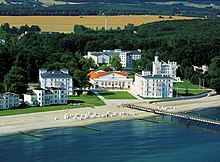
Mecklenburg is a historical region in northern Germany comprising the western and larger part of the federal-state Mecklenburg-Western Pomerania. The largest cities of the region are Rostock, Schwerin, Neubrandenburg, Wismar and Güstrow.

Mecklenburg-Vorpommern ; also known by its anglicized name Mecklenburg–Western Pomerania, is a state in the north-east of Germany. Of the country's sixteen states, Mecklenburg-Vorpommern ranks 14th in population; it covers an area of 23,213 km2 (8,963 sq mi), making it the sixth largest German state in area; and it is 16th in population density. Schwerin is the state capital and Rostock is the largest city. Other major cities include Neubrandenburg, Stralsund, Greifswald, Wismar, and Güstrow. It was named after the two regions of Mecklenburg and Vorpommern, and its name means the "nearer part of Pomerania", with the rest now lying in Poland.

Rostock officially the Hanseatic and University City of Rostock, is the largest city in the German state of Mecklenburg-Vorpommern and lies in the Mecklenburgian part of the state, close to the border with Pomerania. With around 210,000 inhabitants, it is the third-largest city on the German Baltic coast after Kiel and Lübeck, the eighth-largest city in the area of former East Germany, as well as the 39th-largest city of Germany. Rostock was the largest coastal and most important port city in East Germany. The city has a large population of herring gulls that squawk loudly most days throughout the year.
The Michelin Guides are a series of guide books that have been published by the French tyre company Michelin since 1900. The Guide awards up to three Michelin stars for excellence to a select few establishments. The acquisition or loss of a star or stars can have dramatic effects on the success of a restaurant. Michelin also publishes the Green Guides, a series of general guides to cities, regions, and countries.
Northern Germany is a linguistic, geographic, socio-cultural and historic region in the northern part of Germany which includes the coastal states of Schleswig-Holstein, Mecklenburg-Vorpommern and Lower Saxony and the two city-states Hamburg and Bremen. It contrasts with Southern Germany, Western Germany and Eastern Germany.
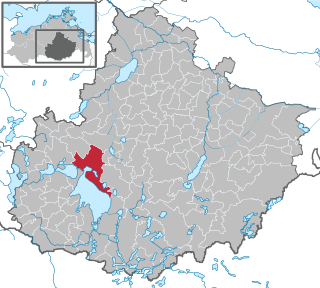
Waren (Müritz) is a town and climatic spa in the state of Mecklenburg-Vorpommern, Germany. It was the capital of the former district of Müritz until the district reform of 2011. It is situated at the northern end of Lake Müritz, approximately 40 kilometres west of Neubrandenburg. Waren is home to the offices of the sub-district (Amt) of Seenlandschaft Waren, although the town itself is independent of any Amt. Its borough is the second largest in Mecklenburg-Vorpommern by area.

Hof van Cleve is a restaurant based in Kruisem, Belgium. The chef is Peter Goossens.
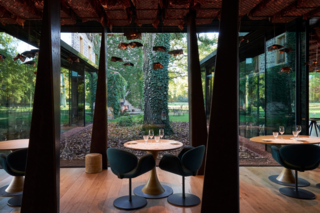
Troisgros is a French restaurant and hotel with a primary location in Ouches and additional affiliated restaurants in Roanne and Iguerande, in France.

Geisel Privathotels is a Munich-based private hotel and gastronomy group founded in 1900 and it includes five hotels and three restaurants. The brothers, Carl, Michael, and Stephan Geisel were awarded the title “Hotelier of the Year” in 2008.
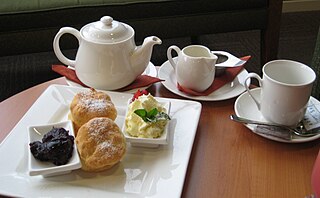
The cuisine of Devon in England has influenced, and been influenced, by other British cuisine.

Resort architecture is an architectural style that is especially characteristic of spas and seaside resorts on the German Baltic coast. The style evolved since the foundation of Heiligendamm in 1793, and flourished especially around the year 1870, when resorts were connected to big cities via railway lines. Until today, many buildings on the German coasts are built in the style or feature distinct elements of resort architecture.
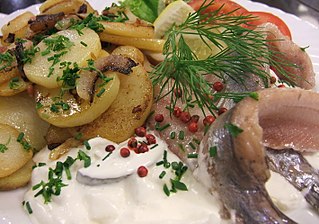
Pomeranian cuisine generally refers to dishes typical of the area that once formed the historic Province of Pomerania in northeast Germany and which included Stettin and Further Pomerania. It is characterised by ingredients produced by Pomeranian farms, such as swede (Wruken) and sugar beet, by poultry rearing, which has produced the famous Pomeranian goose, by the wealth of fish in the Baltic Sea, rivers and inland lakes of the Pomeranian Lake District, and the abundance of quarry in Pomeranian forests. Pomeranian cuisine is hearty. Several foodstuffs have a particularly important role to play here in the region: potatoes, known as Tüften, prepared in various ways and whose significance is evinced by the existence of a West Pomeranian Potato Museum, Grünkohl and sweet and sour dishes produced, for example, by baking fruit.

Édouard Loubet is a French master chef with 2 stars in the Michelin Guide. He obtained the grade of 18/20 from the Gault et Millau book, which elected him chef of the year in 2011.

The cuisine of Brandenburg, a region of Germany, is considered rather down-to-earth compared to other cuisines. Because many people in Brandenburg have Slavonic roots, the cuisine is very much influenced by their habits and customs, such as is the case in Mecklenburg and Pomerania.
Gilles Goujon is a French chef and owner of the restaurant L'Auberge du Vieux Puits in Fontjoncouse, Aude. His restaurant has earned three Michelin stars, the first being awarded in 2010.
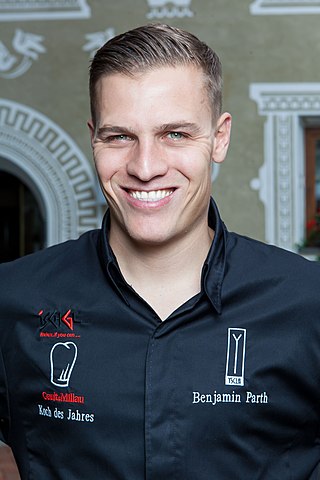
Benjamin Parth is an Austrian chef.

Christian Le Squer is a French three-star Michelin chef at Restaurant Le Cinq, Paris.

Cuisine of Berlin describes different aspects of Berlin's culinary offerings. On the one hand, it means the traditional Berlin cuisine of Berlin households with dishes from the German cuisine. On the other hand, often a rustic pub and snack kitchen, which has become increasingly international due to many migration waves since 1945 and 1990. After 2000, numerous top-class restaurants have evolved in Berlin.
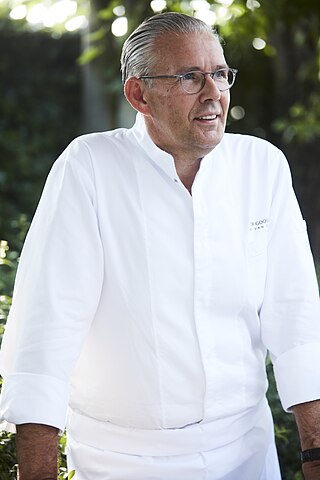
Peter Goossens, is a Belgian chef, Michelin-starred for his restaurant Hof van Cleve. He is known as the "Godfather of Belgian Gastronomy".





